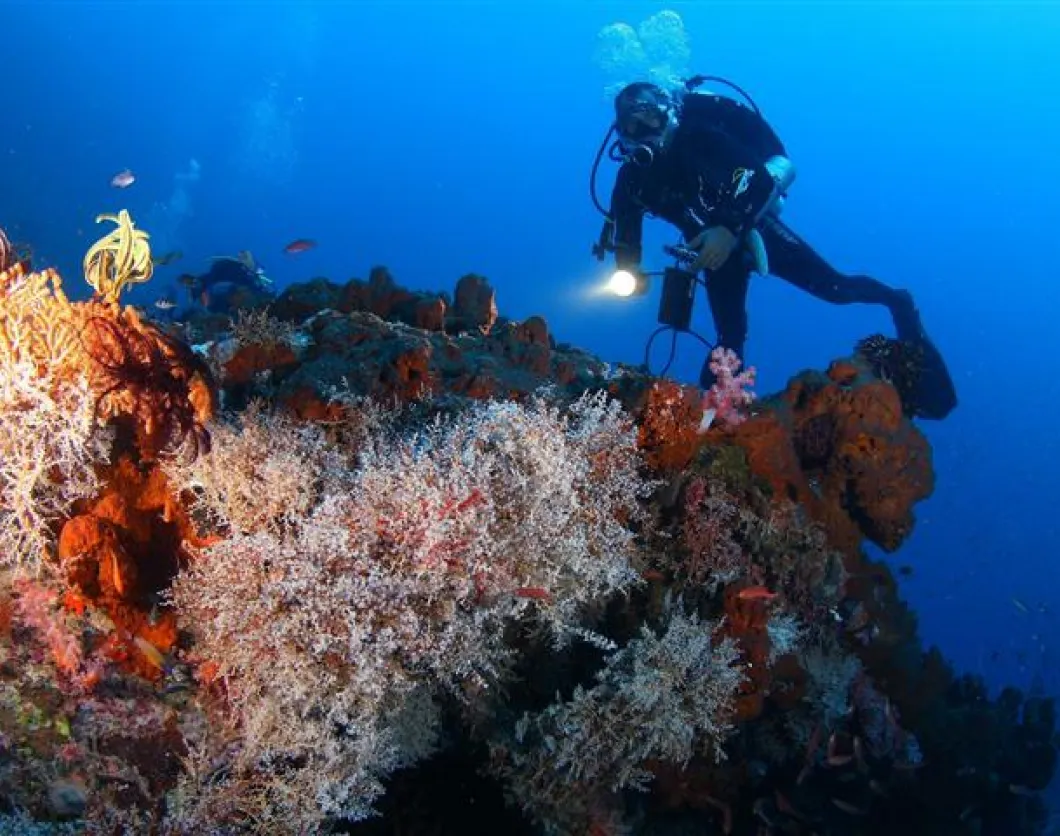Scuba-diving in Bali? Bali is world-renowned for its complex Hindu culture, colourful ceremonies, magnificent volcanic and coastal scenery as well as the artistic and welcoming nature of the Balinese themselves (surely there cannot be a more fascinating island on the planet!) … However, divers may be skeptical when told Bali’s diving is spectacular. Bali repeatedly draws internationally-recognized underwater photographers and journalists from around the globe.
Bali’s Diving
Situated in the heart of the Indo-Pacific, the world’s richest marine biogeographic zone, Bali receives plankton-rich waters and so contains a stunningly diverse underwater ecosystem with many different environments.
Bali’s dive sites offer great diversity: vertical walls; sand slopes; steel and wooden shipwrecks; limestone shorelines; black, volcanic outcrops; peaceful bays; ripping currents; deep, coral-covered ridges, shallow sea grass beds and big bommies, with both shore- and boat-diving.
Pelagics include Manta rays, Whalesharks and, July-November: Mola-Molas (Ocean sunfish). There are over 2,000 species of reef fish in Bali’s waters, in addition to nudibranchs, Mimic octopus and Wonderpus, Ambon scorpionfish, Rhinopias, Mandarinfish, Pyjama and Banggai cardinalfish, ghostpipefish, Pegasus seamoths and Flamboyant cuttlefish to name just a few.
Menjangan Island (offshore island on Bali’s north west point)
Part of West Bali National Park, Menjangan Island was Bali’s first internationally-known diving location. Famous for wall-diving with easy conditions, Menjangan Island is 30 minutes by boat from mainland Bali and offers warm waters with stunning visibility. The island’s white sand beaches provide well-protected snorkeling.
The walls go from 10 to 26-60m+ and are full of nooks and crannies, overhangs and crevasses with soft corals, sponges and Gorgonian seafans (some with pygmy seahorses). The fishlife is prolific and turtles are regular visitors. Although Whalesharks may be sighted, pelagics are fairly rare here as the island is protected from cold ocean currents.
Tulamben Bay (north east Bali)
Tulamben Bay, famous both for its black volcanic sand as well as (only 20 m off the beach) the 120 m USAT Liberty shipwreck – the world’s easiest wreck dive! Drop-off and Coral Garden, is Bali’s most popular diving location. Tulamben offers incredible shore-diving with very easy conditions – perfect for underwater photography.
The resident marinelife includes a huge school of Big-eyed trevally, Bumphead parrotfish and pygmy seahorse. Magical night-diving!
Tulamben is also great for snorkeling and for the 1 Day Introductory Adventure Diving Programme. Note Tulamben has a stony, not sandy, beach. Outside Tulamben Bay are other wonderful sites such as Kubu, Magic Rocks, Emerald, Alamanda, and Batu Kelebit.
Amed (north east Bali)
The small village of Amed was traditionally dependent on salt-panning and fishing and, despite the arrival of tourists, has retained that feeling. Conditions here, either from shore or with outrigger boat, are easy with good visibility.
Lipah Bay (3 km southeast), a small black sand bay, is home to a 20 m steel freighter wreck (5-15 m). Gili Selang on Bali’s eastern point offers both reef- and drift-diving. Amed Ghost Bay is the area’s best muck site.
Padangbai/Candidasa (east coast Bali)
Amuk Bay – with Padangbai to the south and Candidasa to the north – has some of Bali’s most stunning diving. Try Mimpang’s Shark Point, Tepekong’s Canyon and night-diving at Blue Lagoon. Blue Lagoon, is a treasure-trove of marinelife that includes reef sharks, Rhinopias, cuttlefish, Leaf scorpionfish, frogfish, lionfish, and a huge area of Staghorn coral.
The breath-taking diving at both Mimpang (three rock pinnacles) and Tepekong, a 300 m long rock, is for experienced divers only due to the steep walls, cold water and (often strong) currents.
Despite the surge, Biaha, with great diversity of fish, sharks and frequent pelagic visitors set against a backdrop of chiseled black walls with beautiful, healthy corals and often superb visibility, is a popular site.
Nusa Penida/Lembongan (offshore islands on Bali’s east coast)
These two islands offer drift-diving in mild to strong currents, in surprisingly cold water. You may see some turtles, reef sharks and, July-November, Mola-Mola (Ocean sunfish).
The main north coast sites are SD, Ped and Sental with many soft corals and reef fish. Toyapakeh has good visibility and rich, impressive coral formations with big bommies. Late afternoon you may see Mandarinfish.
Gamat Bay and Crystal Bay are best known for sightings of Mola-Mola in water as cold as 19 °C! Also home to the Bali Wobbegong shark. Manta Point 1 has dramatic limestone cliffs descending straight into the ocean. The surge can be strong but no currents. The Mantas are 2-4 m wide and seen at 5-10 m depth.
Lembongan’s Blue Corner – although deep – is a very popular drift dive with the chance to see sharks, big Napoleon wrasse, sometimes Eagle rays and ... Mola-Mola.
By Annabel Thomas (Director, AquaMarine Diving – Bali)
AquaMarine offers only Bali’s better dive locations: these are on the east, northeast and northwest coasts. These careful selections, combined with the experience of their Balinese dive staff and British safety standards, make an unbeatable combination.
AquaMarineDiving.com








